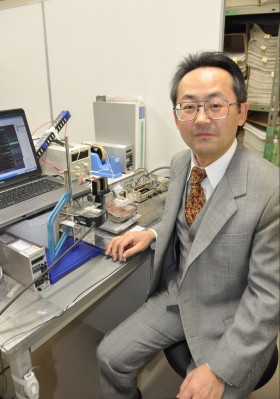Japanese professor has developed rubber, which accumulates the energy of light and mechanical vibrations
 Kunio Shimada, Professor of Hydromechanics and Energy, Fukushima University, Japan, has developed a new type of rubber that converts both solar energy and kinetic energy of mechanical vibrations into electricity. The author says that this is the first material of this kind in the world.
Kunio Shimada, Professor of Hydromechanics and Energy, Fukushima University, Japan, has developed a new type of rubber that converts both solar energy and kinetic energy of mechanical vibrations into electricity. The author says that this is the first material of this kind in the world. Such rubber can be widely used in many areas. For example, like artificial leather for robots, the elastic case of phones and other electronic gadgets. Such a case will not only be shockproof, but will also be able to accumulate energy from every vibration or fall. In the same quality (impact resistance), the material can be used in robotics. Rubber with charging from the sun and vibration is convenient to use for powering multicopter, automobiles, prostheses and other wearable electronics.
By the invention, 53-year-old professor has expressed interest robotehnicheskie company, reported edition of The Japan Times .
Kunio Shimada is a true expert in electrically conductive rubber, he has a number of discoveries in this and related fields. For example, at one time he invented a liquid from dissolved (molten) magnets - the so-called magnetic compound (Magnetic Compound Fluid). In general, the professor has dozens of scientific papers, including 95 scientific articles published since 1991, including 89 in English . As far as the names can understand, all these works are devoted to magnetic compounds., that is, a different version of electrically conductive liquids and solutions. In other words, the professor has been specializing in one research topic for 26 years - and has made significant progress here.
The most cited scientific work of the professor is Effect of magnetic cluster and magnetic field on polishing using magnetic compound fluid (doi: 10.1016 / S0304-8853 (02) 01497-X).
The new substance is made from natural rubber. Typically, in industry, rubber is obtained from natural or synthetic rubber by vulcanization — by mixing with a vulcanizing agent (usually sulfur), followed by heating. But the professor changed the process to electrify the mixture - and got a material with extremely high electrical conductivity.
According to Shimada, he was inspired to study by the example of a colleague Hideki Shirakawa, a professor emeritus at the University of Tsukuba who received the 2000 Nobel Prize in Chemistry for discovering conductivity in polymers . Prior to this invention, it was believed that plastic is not capable of conducting electric current. A chemist from Fukushima wants to dispel about the same misconceptions about rubber.
Conductive polymers can combine the mechanical properties of plastics (flexibility, strength, ductility, elasticity, etc.) with high electrical conductivity. Their properties can be precisely adjusted using special methods of organic synthesis. Many of the advantages of electrically conductive polymers also apply to rubber, which is also capable of accumulating electricity under the influence of sunlight and vibration.
Electrically conductive rubber has several advantages over traditional solar cells, which are usually very fragile and inflexible. In contrast, rubber can expand or contract under the influence of sunlight, generating electricity.
“This material provides potential for future applications in previously unimaginable areas,” said Simada. “This technology inspires big dreams.”
According to a government official from Fukushima Prefecture who is responsible for promoting robotics, Shimada’s technology is able to completely change the design and specifications of robots.
In April 2018, the prefecture plans to open a platform for testing Fukushima Robot Test Field robots in Minamisom. It is hoped that the professor’s electrically conductive rubber will also be included in the test program.
We can add that according to some characteristics, such rubber, which absorbs the energy of vibrations, is similar to the fictional material vibranium from the Marvel Universe. As you know, in the new version, this material had a unique ability to absorb sound, and yet the sound is an air vibration. A type of vibranium found in the isolated African country of Wakanda, it absorbs sound waves and other vibrations, including kinetic energy, which makes this metal stronger. The shield of Captain America and the form of the Black Panther were made of vibranium.
